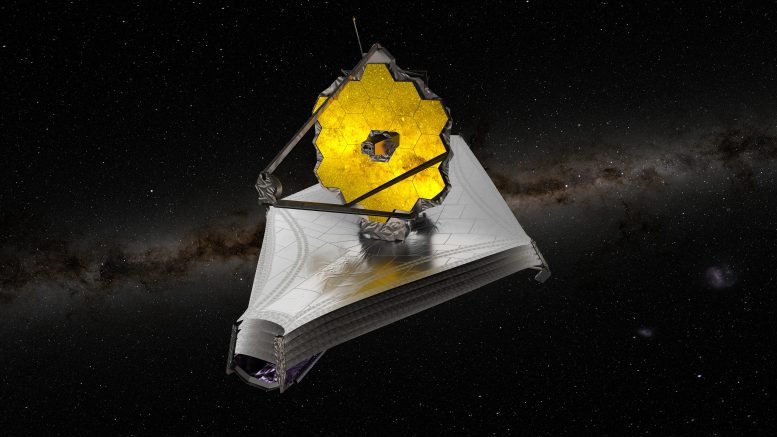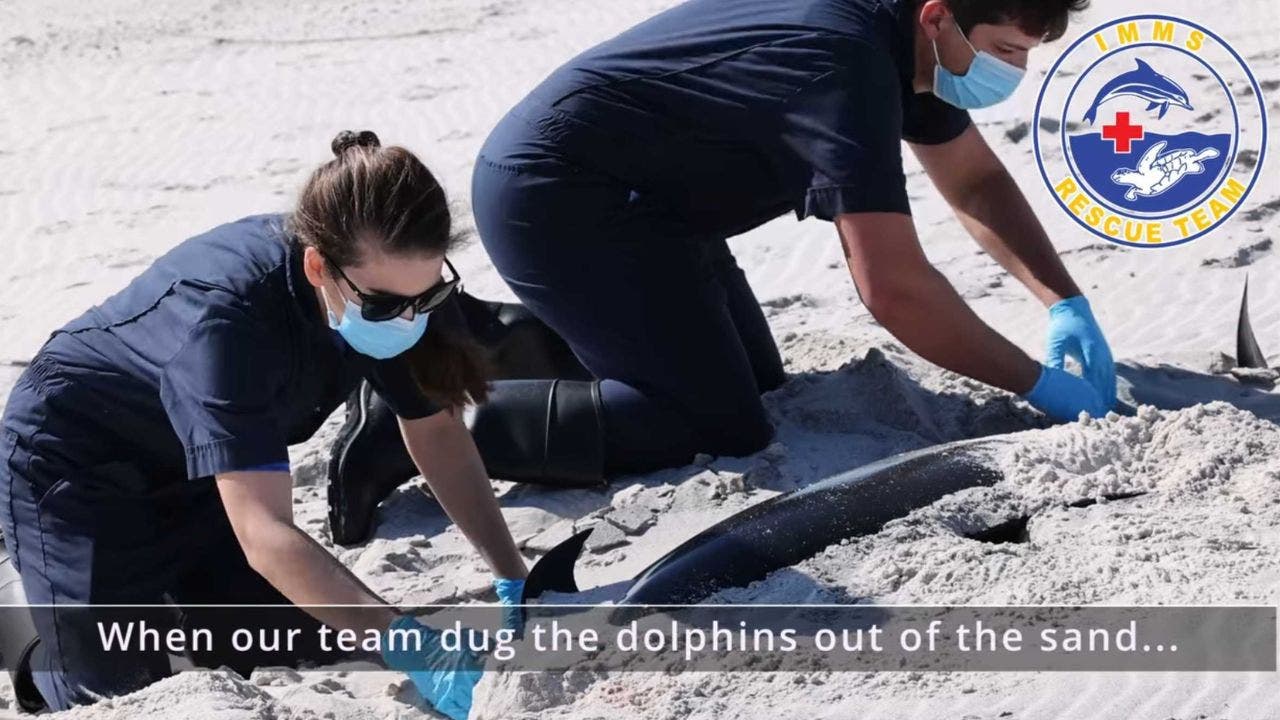Mystery of the “Red Monsters”: Webb Finds Massive Early Galaxies That Shouldn’t Exist
Scitech Daily ^ | November 15, 2024 | University of Geneva
Posted on 11/15/2024 6:02:08 AM PST by Red Badger

credit: NASA/CSA/ESA, M. Xiao & P. A. Oesch (University of Geneva), G. Brammer (Niels Bohr Institute), Dawn JWST Archive
Researchers using the James Webb Space Telescope have discovered three massive galaxies from the early universe, revealing them to be as massive as the Milky Way and forming stars with surprising efficiency.
This finding, which contradicts earlier models of slow stellar formation, suggests that star formation in the early universe was much more productive than previously believed.
Three Galactic “Red Monsters” Discovered in the Early Universe
An international research team, led by the University of Geneva (UNIGE), has discovered three ultra-massive galaxies, each nearly as large as the Milky Way, that existed within the first billion years after the Big Bang. This unexpected finding was made using the James Webb Space Telescope’s FRESCO program, which leverages the NIRCam/grism spectrograph to precisely measure the distances and stellar masses of galaxies.
The results suggest that star formation in the early Universe was significantly more efficient than previously believed, challenging established models of galaxy formation. These findings were published in Nature on November 13.
Challenge to Conventional Galaxy Formation Theories
According to the prevailing scientific model, galaxies gradually form within vast halos of dark matter, which draw in gas (atoms and molecules) to form gravitationally bound structures. Typically, only about 20% of this gas converts into stars within galaxies. However, the new observations from UNIGE’s team, utilizing NASA’s James Webb Space Telescope (JWST), question this view. The data indicate that massive galaxies in the early Universe may have formed stars at a much higher rate than later galaxies, growing far more rapidly than once thought.
“Our findings are reshaping our understanding of galaxy formation in the early Universe.” Dr. Mengyuan Xiao
Unveiling the “Red Monsters”
JWST’s unparalleled capabilities have allowed astronomers to systematically study galaxies in the very distant and early Universe, providing insights into massive and dust-obscured galaxies. By analyzing galaxies in the FRESCO survey, scientists found that most sources fit existing models.
However, they also found three surprisingly massive galaxies, with stellar masses comparable to today’s Milky Way. These are forming stars nearly twice as efficiently as their lower-mass counterparts and galaxies at later times. Due to their high dust content, which gives them a distinct red appearance in JWST images, they have been named the three “Red Monsters.”
“Our findings are reshaping our understanding of galaxy formation in the early Universe,” says Dr. Mengyuan Xiao, lead author of the new study and postdoctoral researcher in the Department of Astronomy at UNIGE Faculty of Science. “The massive properties of these ‘Red Monsters’ were hardly determined before JWST, as they are optically invisible due to dust attenuation,” says Dr. David Elbaz, director of research at CEA Paris-Saclay.

Webb Wallpaper The James Webb Space Telescope is a revolutionary tool in space exploration, capable of peering into the early Universe and uncovering distant galaxies, stars, and planets. Using infrared technology, it reveals details hidden from previous telescopes. Credit: ESA/ATG medialab
New Frontiers in Galactic Exploration
The international team has developed a new program with the JWST to systematically analyze a complete sample of emission-line galaxies within the first billion years of cosmic history. This approach enabled the team to achieve precise distance estimates and reliable stellar mass measurements for the full galaxy sample.
“Our findings highlight the remarkable power of NIRCam/grism spectroscopy,” explains Pascal Oesch, associate professor in the Department of Astronomy at the UNIGE Faculty of Science, principal investigator of this observation program. “The instrument on board the space telescope allows us to identify and study the growth of galaxies over time, and to obtain a clearer picture of how stellar mass accumulates over the course of cosmic history.”
“Too Many, Too Massive” Galaxies in the Early Universe
While these findings do not conflict with the standard cosmological model, they raise new questions for galaxy formation theories, specifically the issue of “too many, too massive” galaxies in the early Universe. Current models may need to consider unique processes that allowed certain early massive galaxies to achieve such efficient star formation and thus form very rapidly, very early in the Universe. Future observations with JWST and the Atacama Large Millimeter Array (ALMA) will provide further insights into these ultra-massive “Red Monsters” and reveal larger samples of such sources.
“These results indicate that galaxies in the early Universe could form stars with unexpected efficiency,” Dr. Mengyuan Xiao concludes. “As we study these galaxies in more depth, they will offer new insights into the conditions that shaped the Universe’s earliest epochs. The ‘Red Monsters’ are just the beginning of a new era in our exploration of the early Universe.”
Reference:
“Accelerated formation of ultra-massive galaxies in the first billion years”
by Mengyuan Xiao, Pascal A. Oesch, David Elbaz, Longji Bing, Erica J. Nelson, Andrea Weibel, Garth D. Illingworth, Pieter van Dokkum, Rohan P. Naidu, Emanuele Daddi, Rychard J. Bouwens, Jorryt Matthee, Stijn Wuyts, John Chisholm, Gabriel Brammer, Mark Dickinson, Benjamin Magnelli, Lucas Leroy, Daniel Schaerer, Thomas Herard-Demanche, Seunghwan Lim, Laia Barrufet, Ryan Endsley, Yoshinobu Fudamoto, Carlos Gómez-Guijarro, Rashmi Gottumukkala, Ivo Labbé, Dan Magee, Danilo Marchesini, Michael Maseda, Yuxiang Qin, Naveen A. Reddy, Alice Shapley, Irene Shivaei, Marko Shuntov, Mauro Stefanon, Katherine E. Whitaker and J. Stuart B. Wyithe, 13 November 2024, Nature.
DOI: 10.1038/s41586-024-08094-5
TOPICS: Astronomy; History; Science
KEYWORDS: jameswebb; spacetelescope
Dear FRiends, Please use this temporary link to donate by credit card via Authorize.Net:
Or click here to donate by PayPal
Or by mail to: Free Republic, LLC - PO Box 9771 - Fresno, CA 93794
Hopefully, we'll have our normal CC system up and running again soon. Thank you very much for your loyal support!
1 posted on 11/15/2024 6:02:08 AM PST by Red Badger
To: MtnClimber; SunkenCiv; mowowie; SuperLuminal; Cottonbay
Webb Ping!..................
2 posted on 11/15/2024 6:02:35 AM PST by Red Badger (Homeless veterans camp in the streets while illegals are put up in 5 Star hotels....................)
Disclaimer: Opinions posted on Free Republic are those of the individual posters and do not necessarily represent the opinion of Free Republic or its management. All materials posted herein are protected by copyright law and the exemption for fair use of copyrighted works.
FreeRepublic.com is powered by software copyright 2000-2008 John Robinson

 By Free Republic | Created at 2024-11-15 14:03:57 | Updated at 2024-11-28 10:51:57
1 week ago
By Free Republic | Created at 2024-11-15 14:03:57 | Updated at 2024-11-28 10:51:57
1 week ago








